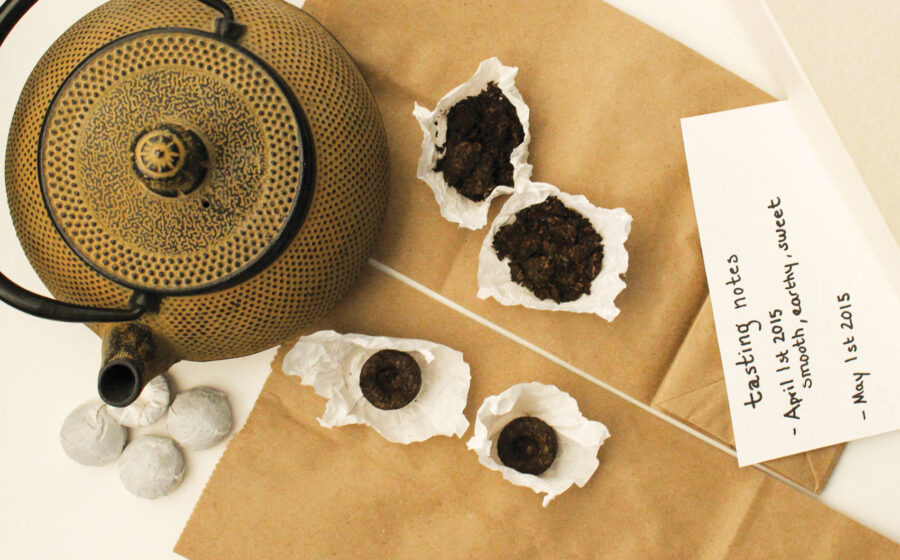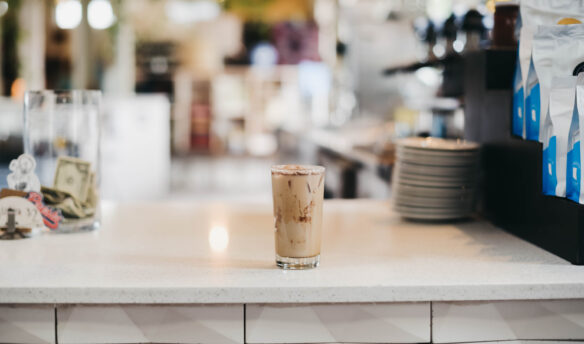[T]ucked down in dark cellars you’ll find prized wine collections with labels just barely peeling from treasured bottles. Out of the cave and into the fridge, wedges of aged cheeses continue to ripen within their neatly folded paper. And in my front hall closet, if you stand on the tips of your toes, you’ll see two thin cardboard boxes, each containing a paper bag of aging pu-erh. It’s simple to house-age teas over time in hopes of fostering new flavors. But before you start filling empty spaces in your house, café, or restaurant with tea leaves, consider that this particular process of aging is meant for pu-erh, as green sheng pu-erh leaves still contain enough moisture and micro-organisms for post-production fermentation, allowing us to partake in the development of this tea’s well-known, earthy flavors.
Pu-erh leaves are sun-dried and aged via natural fermentation to reveal complex tastes that vary depending on the style of either a sheng (meaning green, raw) or shu (ripe, cooked) pu-erh. Sheng is ideal for an aging experiment, as the leaves are minimally processed to allow time to take its toll via continued oxidation. To be even more specific, sheng still has active micro-organisms (though most are eliminated during the sun-drying stage), a key element in pu-erh’s flavor. These remaining micro-organisms, when treated with care, allow the opportunity to experience a more intense flavor journey over time. Young sheng pu-erh teas start out smooth and fresh, with subtle sweet fruit notes sometimes balanced with a quiet bitter taste, all of which will age and transform to exhibit depth, earthiness, and complexity.
Hopefully, one day we will find house-aged pu-erh experiments hidden on shelves in friends’ homes, and on menus at cafés or restaurants.
Note that aging sheng pu-erh is an art that involves great patience, considering that true taste alteration should reveal itself after approximately five years. But don’t let that deter you from tasting every few months to track the tea’s progress and enjoy the flavor journey. Keep in mind that pu-erh tea is prized for its maturity, often being tucked away for ten to forty years, but you may begin noticing changes early in the process.
If sheng pu-erh isn’t as readily available or you prefer to experience a more subtle alteration of flavor, opt for shu pu-erh teas that have already been exposed to controlled moisture and heat levels, allowing the tea to mature at an accelerated rate. The steeped flavors of cooked shu pu-erhs will generally have an earthy depth, with sweetness and rich mouthfeel that can be described as having musty, mushroom aroma and flavor. Note that during the process of “cooking” shu pu-erh the micro-organisms are eliminated, and thus the process of house-aging leans more toward gently removing or altering a pre-existing flavor in the tea.
Once you’ve obtained your tea, check the variables of the spot where it will age. Humidity should register between sixty to seventy percent. This will encourage an ideal rate of micro-organism growth—too high and you will find mold, too low and aging will not occur. (So avoid damp basements.) For an exact measurement of humidity, cigar stores often sells inexpensive tools to measure humidity levels.
You will also want to store the tea away from strong odors (I recommend the top shelf of a closet rather than a food or spice pantry). Placing an open container of baking soda in proximity to the pu-erh can also help to absorb unwanted odors. The recommendation of a coat closet is ideal, as you also want to maintain dark conditions since light negatively affects the tea. Stable temperature is also necessary, with a recommendation of sixty-eight to eighty-six degrees Fahrenheit.
Let your pu-erh tea breathe by keeping it out of airtight plastic bags or stainless steel tins. Traditionally pu-erh is aged in unglazed yixing clay pots, a porous and breathable material. However, you can also use a paper bag (sandwich bags are a great size) in a cardboard box. Breathable packaging provides airflow to allow the oxidation to take place while maintaining healthy micro-organisms. If you’re storing in a dark closet, make sure that you leave the door slightly ajar (but not wide open) for adequate airflow.
Now that you’ve created the ideal home for the tea, note whether it’s loose or compressed into a brick or disc. For a faster aging process, you will want to break up the compressed brick to expose more surface area to oxygen. To age the tea slower, simply place the loose or compressed tea into the paper bag and follow the above rules (ideal for shu pu-erh). To age the tea for a longer period of time, place the tea-filled paper bag into a cardboard box and follow the recommended storage conditions (ideal for sheng pu-erh).
Considering that this is a tea journey, document the beginning of the adventure with a tasting (with friends at home or customers at your café or restaurant). Steep a small portion of the tea prior to tucking it away and capture the date and tasting notes in a journal so you can compare the flavors as the pu-erh matures. Hopefully, one day we will find house-aged pu-erh experiments hidden on shelves in friends’ homes, and on menus at cafés or restaurants as an evening or after-dinner digestif, paired with an expertly aged cheese, of course.
—Alexis Siemons is a regular contributor to Fresh Cup.















